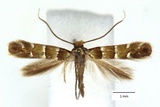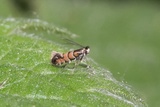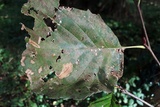Phyllonorycter stettinensis (Nicelli, 1852) Species
Last modified: Dec. 10, 2025, 6:04 p.m.
A fairly common species throughout Belgium, especially in the northern part of the country.
Details
- Classification
- Family: Gracillariidae > Subfamily: Lithocolletinae > Genus: Phyllonorycter > Species: Phyllonorycter stettinensis
- Vernacular names
- Elzenblaasmijnmot (NL), Small alder midget (EN), Oberseitige Erlen-Faltenminiermotte (DE)
- First mention in Belgium
- De Fré Ch. 1858. Catalogue des Microlépidoptères de la Belgique. — Annales de la Société entomologique belge 2: 45–162. On page 157 (as L.[ithocolletis] Stettinella. Nic.). view page
- Status
-
Native
Distribution
Imago
Head brown; forewing ochreous brown, white pattern consisting of two transverse bands, a very short basal streak; three costal and two dorsal striae, the first ones often merged in the middle of the wing and the last ones sometimes very small; a patch of dark brown scales in the apical area.
Mine
A rather small, at first semi-circular or oval, tentiform mine on the upperside of a leaf; later growing into a more elongated mine. The mine does not contort the leaf much; it is yellowish-green and has one longitudinal fold in the centre. The mine is often situated on top of a secondary vein. The frass is concentrated in a corner of the mine.
See also gracillariidae.net and bladmineerders.be.
Cocoon/pupa
The last instar of the summer generation makes a very flimsy spinning, that of the autumn generation constructs a tough, white cocoon.
Bionomics
The species hibernates in the pupal stage, between leaf litter on the ground. After emergence of the adult, the pupal skin protrudes through the mine.
Flight periods
Two generations a year in May and August.
Observed on
- Host plant (species):
- Alnus glutinosa, Alnus incana and Alnus cordata
The larva lives mainly on Alnus glutinosa, but it has also been recorded from Alnus incana and Alnus cordata.




